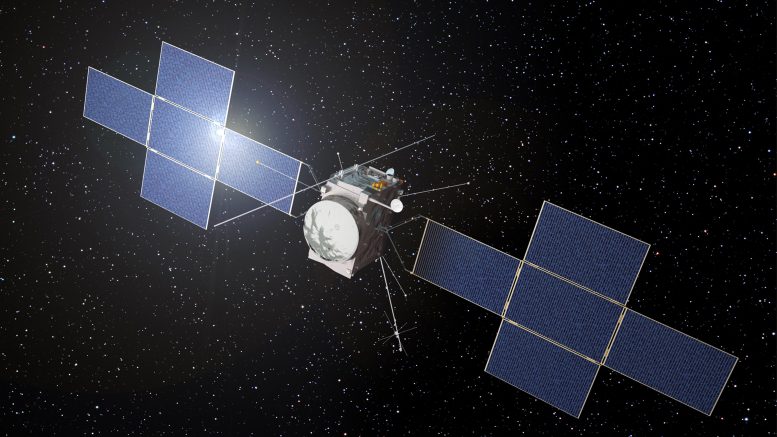
ESA’s Jupiter Icy Moons Explorer, Juice, will make detailed observations of the giant gas planet and its three large ocean-bearing moons – Ganymede, Callisto, and Europa – with a suite of remote sensing, geophysical, and in situ instruments. The mission will characterize these moons as both planetary objects and possible habitats, explore Jupiter’s complex environment in-depth, and study the wider Jupiter system as an archetype for gas giants across the Universe. Credit: ESA
Flight controllers at ESA’s mission control center in Germany were busy last week, working with instrument teams on the final deployments to prepare ESA’s Jupiter Icy Moons Explorer (Juice) for exploring Jupiter.
It has been six weeks since Juice began its journey, and in that time the Flight Control Team has deployed all the solar panels, antennas, probes, and booms that were tucked away safely during launch. The last step has been the swinging out and locking into place of the probes and antennas that make up Juice’s Radio & Plasma Wave Investigation (RPWI).
“It’s been an exhausting but very exciting six weeks,” says Angela Dietz, deputy spacecraft operations manager for the mission. “We have faced and overcome various challenges to get Juice into the right shape for getting the best science out of its trip to Jupiter.”
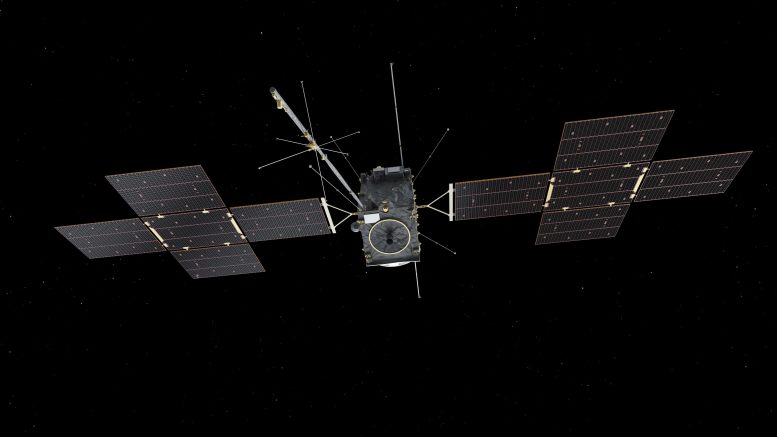
Illustration of the JUICE spacecraft in space. Six weeks after launch, it is now fully prepared for its mission to Jupiter. All onboard equipment, including groundbreaking instruments like the RPWI for 3D mapping of electric fields and the JANUS optical camera for studying icy moons, have been deployed and confirmed operational. Despite minor issues, all systems are expected to be fully functional by mid-July. Credit: ESA (acknowledgment: ATG Medialab)
We’ve had regular snapshots of the entire deployment process thanks to Juice’s two onboard monitoring cameras, each with a different field of view. In the hours after launch, these cameras took Juice’s first ‘selfies’ from space, and ever since, they have been vital for checking that all parts of the spacecraft deployed correctly.
Juice’s antennas and booms each carry part or all of some of Juice’s 10 instruments. By placing them far from Juice, the instruments that need to be separated from the spacecraft’s own electric and magnetic fields are kept at a distance.
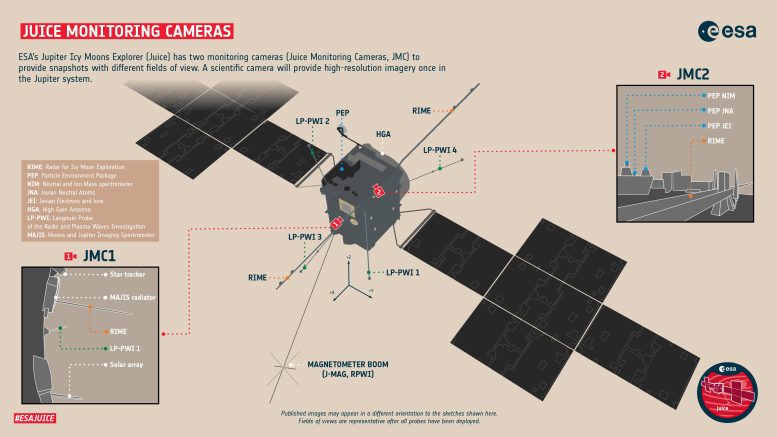
ESA’s Jupiter Icy Moons Explorer, Juice, has two monitoring cameras (Juice Monitoring Cameras, JMC) to provide snapshots with different fields of view. Credit: ESA
This powerful instrument package will collect data that helps us answer questions like: What are Jupiter’s ocean worlds like? Why is Ganymede so unique? Could there be – or ever have been – life in the Jupiter system? How has Jupiter’s complex environment shaped its moons, and vice versa? What is a typical gas giant planet like – how did it form, and how does it work?
Accompanying our views from the monitoring cameras, confirmation that everything deployed as planned also came from the instruments themselves. The teams behind some of the instruments have been switching them on and making measurements to check that everything is working well. Teams have already confirmed that Juice’s RPWI, JANUS, J-MAG, and GALA instruments, as well as the RADEM radiation monitor, are ready for Jupiter.
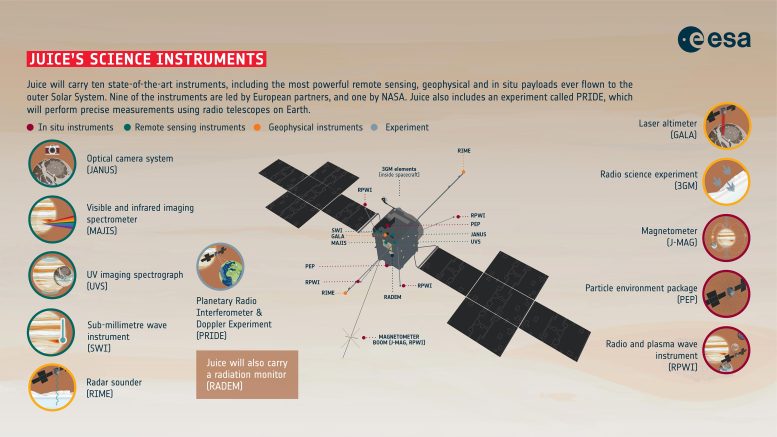
ESA’s Jupiter Icy Moons Explorer (Juice) is carrying the most powerful remote sensing, geophysical, and in situ payload complement ever flown to the outer Solar System. It includes 10 dedicated scientific instruments, a radiation monitor (RADEM), and the Planetary Radio Interferometer & Doppler Experiment (PRIDE). Credit: ESA
RPWI: five days, seven deployments
This week, the four Langmuir Probes and three Radio Wave Instrument antennas of the Radio & Plasma Wave Investigation (RPWI) were successfully deployed. Altogether these make up seven of the 10 RPWI sensors that will measure the variations in the electric and magnetic fields around Jupiter, as well as radio waves and cold plasma.
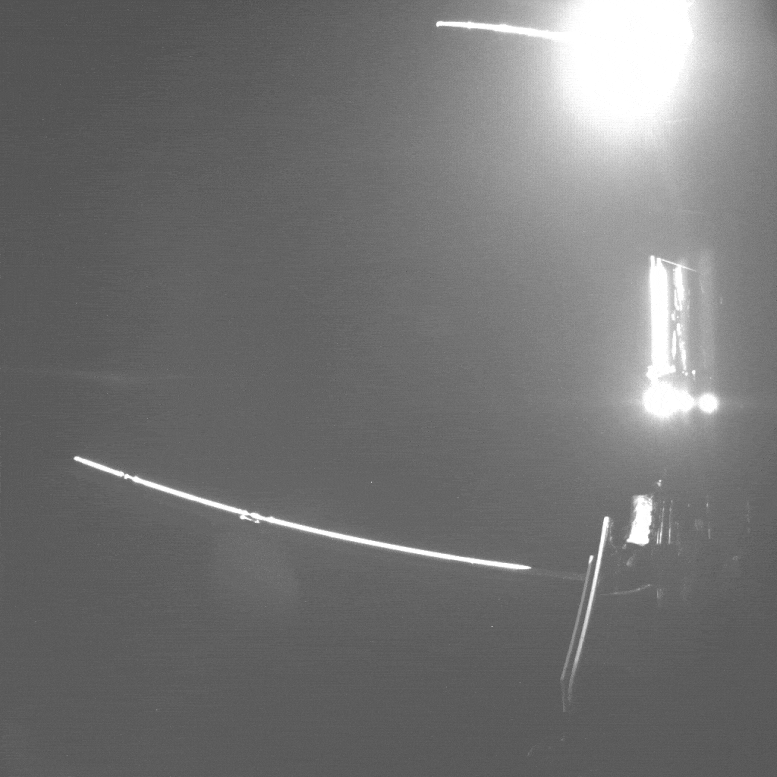
This animation, made up of images from the Juice monitoring camera, shows the fourth Langmuir Probe deploying. Between 22 and 26 May 2023, the four Langmuir Probes and three Radio Wave Instrument antennas of the Radio & Plasma Wave Investigation (RPWI) were successfully deployed. Altogether these make up seven of the 10 RPWI sensors that will measure the variations in the electric and magnetic fields around Jupiter, as well as radio waves and cold plasma. Credit: ESA/Juice/JMC
After seeing the last boom deploy successfully this afternoon, principal investigator of RPWI, Jan-Erik Wahlund from the Swedish Institute of Space Physics said: “Fantastic, after more than 10 years of intensive work, we are finally ready for science discoveries!”
RPWI will be the first-ever device to generate a 3D map of the electric fields around Jupiter. It will give us valuable information on how energy is transferred between Jupiter’s enormous rotating magnetosphere and the large icy moons Ganymede, Callisto, and Europa. This energy transfer drives, for example, the auroras on Ganymede and in Jupiter’s upper atmosphere. The special sensitivity of RPWI to low frequencies means that it will be able to detect very weak electromagnetic signals from tides and currents within the sub-surface oceans of the icy moons.
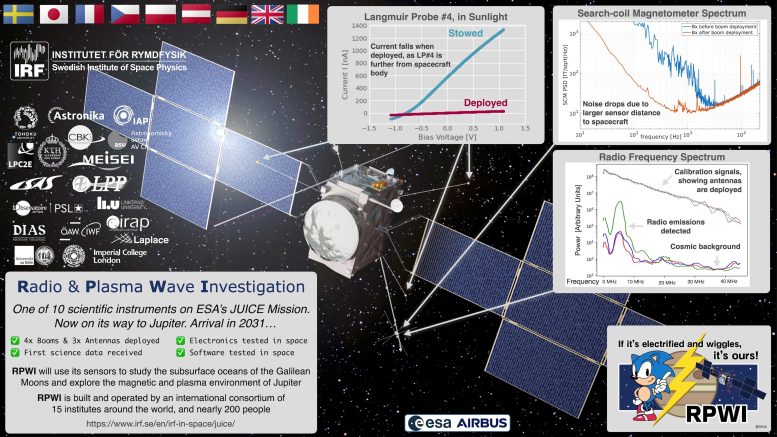
Juice is humankind’s next bold mission to the outer Solar System. After an eight-year journey to Jupiter, it will make detailed observations of the gas giant and its three large ocean-bearing moons: Ganymede, Callisto, and Europa. This ambitious mission will characterize these moons with a powerful suite of remote sensing, geophysical and in situ instruments to discover more about these compelling destinations as potential habitats for past or present life. Juice will monitor Jupiter’s complex magnetic, radiation, and plasma environment in depth and its interplay with the moons, studying the Jupiter system as an archetype for gas giant systems across the Universe. Credit: ESA/Juice/RPWI consortium
Before and after each deployment, the RPWI team switched on the instrument to measure the difference made by each newly deployed sensor. Each one now collects data and delivers it to RPWI’s onboard data processing unit, which sends the data down to Earth.
“Our 3D design strategy makes it possible to measure true physical observables, such as energy and momentum, without resorting to theories or simulations to interpret the data,” says Jan Bergman, a researcher at the Swedish Institute of Space Physics and technical manager for RPWI.

Image sequence of seven acquisitions performed by the JANUS instrument onboard ESA’s Jupiter Icy Moons Explorer (Juice) covering an area of sky measuring 1.3 x 1.7 degrees sky. The image at the center is eta Cyg (the twelfth star in brightness order in Cygnus constellation). Many other stars light up as the integration time increases from about 2 to 200 milliseconds. The star field was selected to avoid a complex pointing request to Juice, involving thermal gradients on the instrument, while allowing JANUS to observe stars of different brightness and spectral type, to verify the optical quality, distortion, and spectral response. Credit: ESA/Juice/JANUS consortium
JANUS: first images taken in space
Last week, when Juice was about 8 million km from Earth, engineers switched the JANUS optical camera instrument on for the first time. Unlike the RPWI sensors mounted on booms far from Juice’s main body, JANUS is fixed to an optical bench; this means that it is kept stable when pointing towards its targets – like using a tripod here on Earth. JANUS also points in the same direction as Juice’s other ‘remote sensing’ instruments.
At Jupiter, the JANUS camera will take images in 13 different colors, from violet light to near-infrared. These images will allow scientists to investigate the moons Ganymede, Callisto and Europa, including studying whether life could exist below their icy crusts. JANUS will also collect data on other parts of the Jovian system, including the intense volcanic activity on Io, the many smaller moons, and Jupiter’s faint ring system. Last but not least, JANUS will image processes taking place in Jupiter’s atmosphere.
During last week’s commissioning, a full hardware check was undertaken, with all subsystems activated and monitored. The performance of the instrument was checked by taking images of stars.
“The acquired data demonstrate that everything was nominal. After this intense on-ground session, we can say: we have a (fully commissioned) instrument!” says Pasquale Palumbo (IAPS-INAF), principal investigator of JANUS.
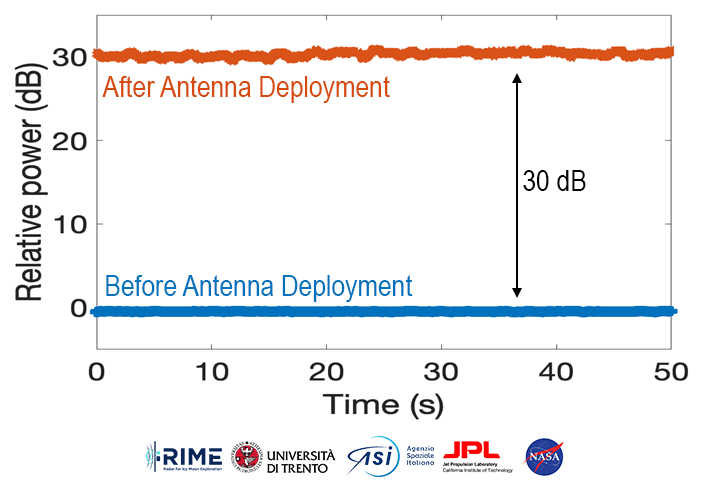
Background noise measured by the RIME receiver (1 MHz bandwidth mode) onboard ESA’s Jupiter Icy Moons Explorer (Juice). The plot shows data collected before (in blue) and after (in orange) the complete antenna deployment. With the 16-meter antenna open, the sensitivity increased by 1000 times (or 30 dB) and reached the nominal value. Credit: ESA/Juice/RIME consortium
RIME: a sticky situation, finally unstuck
The journey to full deployment has not been entirely smooth sailing. Just a few days after launch, flight controllers attempted to unfurl the Radar for Icy Moon Exploration (RIME) instrument antenna. The first segments of the antennas unfolded as planned, but the next segments refused to budge.
Controllers suspected that a tiny stuck pin jammed the segments in place. They put their heads together to figure out a solution. They shook Juice using its thrusters. They warmed Juice using sunlight. Every day the antenna showed signs of movement, but stayed stuck in its bracket. Finally, RIME was jolted into life almost three weeks later, when the team fired a mechanical device inside the bracket. The shock moved the pin by a matter of millimeters. To the relief of ESA operations and project teams as well as industry, the antenna fully unfolded.
Commissioning of RIME is still ongoing, but the team has already made some measurements with the instrument.
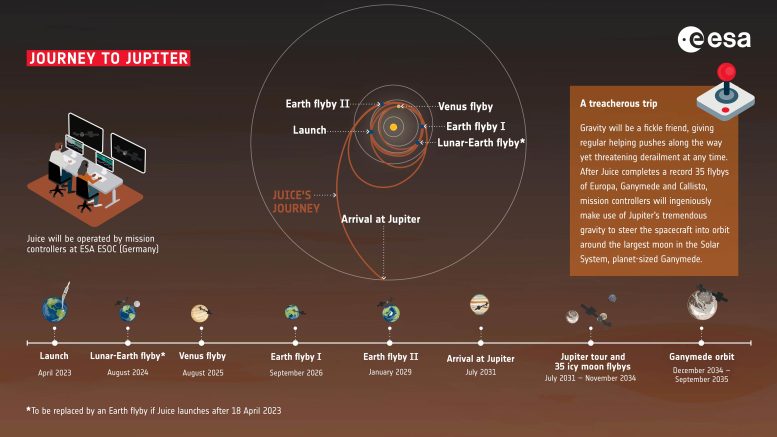
ESA’s Jupiter Icy Moons Explorer (Juice) embarked on an eight-year cruise to Jupiter starting in April 2023. The mission will investigate the emergence of habitable worlds around gas giants and the Jupiter system as an archetype for the numerous giant planets now known to orbit other stars.
On its journey Juice will make a series of flybys of Earth, the Earth-Moon system and Venus to set it on course for its July 2031 rendezvous in the Jovian system.
Juice will make three Earth flybys during its cruise: one of the Earth-Moon system in August 2024, one of Earth in September 2026, and once again one of Earth in January 2029.
In total Juice will spend approximately eight years cruising to Jupiter. It will reach Jupiter in July 2031, but will already begin making scientific observations six months before entering orbit around Jupiter. Juice will go on to spend many months orbiting Jupiter, making 35 flybys of icy moons Europa, Ganymede, and Callisto, and finally conducting an orbital tour of Ganymede. Credit: ESA
What’s next for Juice?
In the next weeks, more of Juice’s 10 instruments will be switched on and checked, with the hope that by mid-July, all instruments will be working perfectly, ready for cruising to Jupiter.
In August 2024, Juice will carry out the world’s first-ever lunar-Earth gravity assist. By performing this maneuver – a gravity assist flyby of the Moon followed just 1.5 days later by one of Earth – Juice will be able to save a significant amount of propellant on its journey.

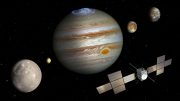
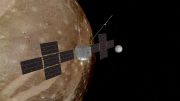


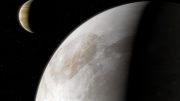
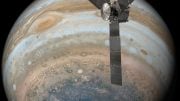

Be the first to comment on "Jupiter Bound: Juice Spacecraft Deployments Complete"